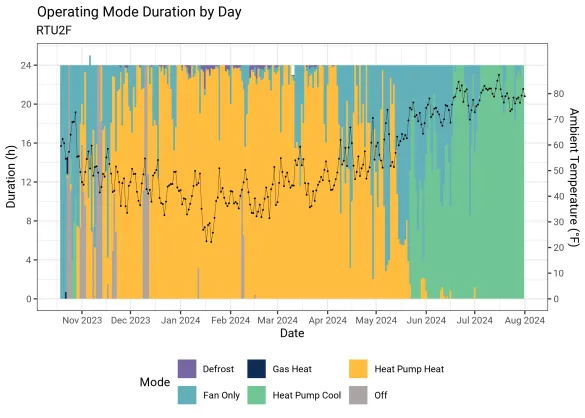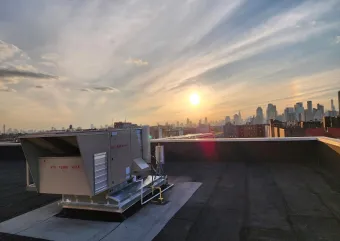Background and goals
Center for Energy and Environment’s (CEE) research team completed a nine-month study in Queens, New York monitoring the performance of two Daikin Rebel dual fuel heat pump rooftop units (RTUs). These units combine a heat pump as the primary heating source with a gas furnace as backup, making them well suited for cold climate regions. Daikin U.S. had an existing relationship with the building manager, and contracted CEE to conduct a pilot study which aimed to:
- Demonstrate the energy efficiency and emission reduction potential of dual fuel heat pump RTUs in mixed-use commercial buildings.
- Evaluate the performance and heating capacity of the RTUs during a full heating season.
- Provide data to support adoption of dual fuel heat pump RTUs as a low emission HVAC solution.
CEE and Daikin U.S. are both partners in the U.S. Department of Energy’s (DOE) Commercial Building Heat Pump Accelerator challenge, which encourages the adoption of dual fuel heat pump RTUs for achieving energy savings and emission reductions.
Project Overview
The report evaluates the performance of two 15-ton Daikin Rebel dual fuel heat pump RTUs (RTU2F and RTU3F) installed on the roof of a mixed-use commercial building including healthcare and financial services. The units served the back zones of the second and third stories. Performance was monitored from October 19, 2023, to July 31, 2024, using remote data loggers.
Performance and benefits
Energy and emissions savings
Compared to a standard RTU in the same application,
- RTU2F reduced site energy use by 72% and source emissions by 58%.
- RTU3F reduced site energy use by 69% and source emissions by 55%.
Emissions savings were calculated based on guidance from New York City Local Law 97 (NYC LL97), which requires buildings over 25,000 square feet to meet certain emission limits.
Performance and efficiency
During the heating season, this study found that less than 1% of the heating capacity delivered was from gas combustion.
- RTU2F delivered 100% of its heating capacity via the heat pump
- RTU3F delivered 99% of its heating capacity via the heat pump
Average Seasonal Efficiency (COP)
- RTU2F: 2.59 (3.19 in heat pump mode)
- RTU3F: 2.53 (3.07 in heat pump mode)
Results and next steps
Performance was summarized in plots describing operating modes, efficiency, and delivered heating energy by energy source and ambient conditions. Find all the details in the full report.
CEE expresses gratitude to those who supported this research. Special thanks to Daikin Comfort Technologies and Daikin Applied Americas.

